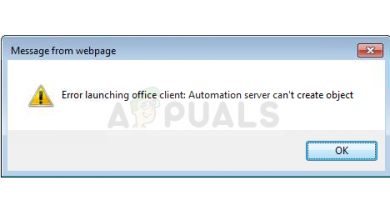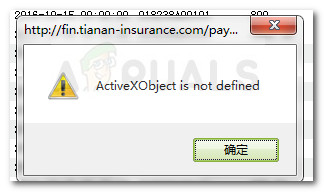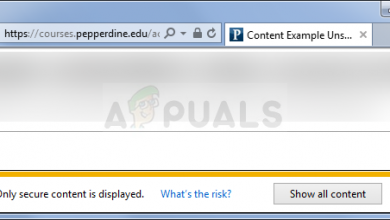‘Res IEFrame DLL ACR_Error.HRM’ Error in Internet Explorer [Fix]
Some Windows users are reporting that they end up seeing the ‘Res IEFrame DLL ACR_Error.HRM‘ error whenever they attempt to reopen a previously closed browsing session in Internet Explorer. This problem is confirmed to occur on Windows 7, Windows 8.1, and Windows 10.
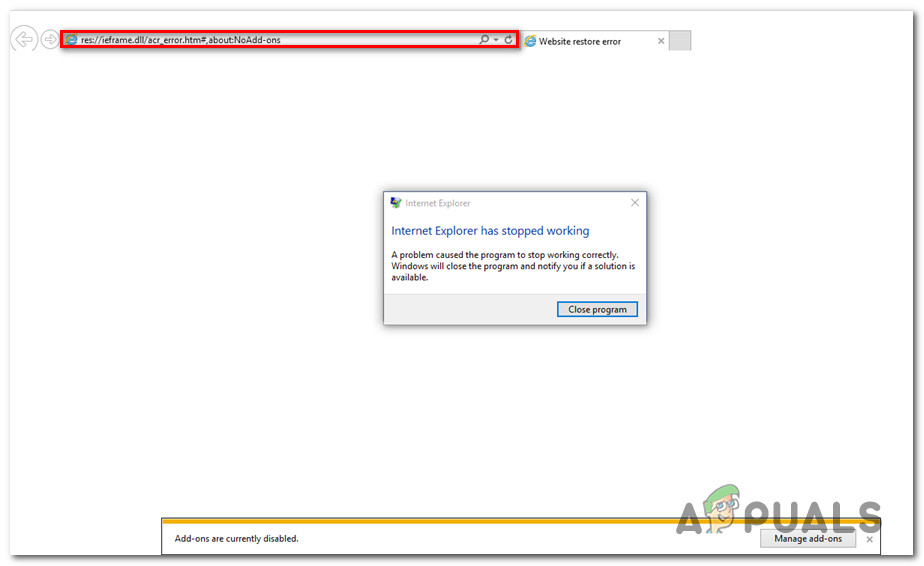
After investigating this particular issue thoroughly, it turns out that there are several different potential culprits that might end up triggering this error with Internet Explorer. Here’s a list of potential culprits:
- IE Conflicting Add-on – As it turns out, one of the most common instances that will spawn this error is an instance in which a problematic add-on is causing this error with IE. Typically, this problem will occur due to a browser hijacker or a PUP that’s interfering with the functionality of IE. If this scenario is applicable, you should be able to fix the problem by disabling every IE Add-on that’s currently active on your local installation.
- Failing IE script – According to a lot of affected users, you can expect to see this issue due to a failing IE script that is forced to run at every browser startup. In this case, one way to take care of this issue is to do a complete IE reset using the Internet Properties menu.
- Corrupted temp files in IE – Under certain circumstances, you can expect to see this error due to some type of corruption that’s currently affecting the suite of temp files that are stored by your browser. In this case, you should be able to fix the problem by clearing the entire suite of temporary files using the Internet Options menu. In certain circumstances, you might need to use a 3rd party utility like CCleaner to get rid of the corrupted temp files.
- Missing Java Runtime Environment – As it turns out, you can also expect to see this error code in instances where your Windows installation is missing the Java Runtime Environment (JRE). Depending on the actions that you are undergoing when this error appears, you should be able to fix the problem by installing the JRE package conventionally.
- System File Corruption – There are some documented situations where this error code is actually related to some type of underlying system file corruption that can only be resolved with specialized utilities like DISM and SFC. If this scenario is applicable, run the necessary scans and see if they end up fixing the problem.
Now that you know the most common issues that might cause the ‘Res IEFrame DLL ACR_Error.HRM‘ error, here’s a list of sub-guides that you can use to fix this error:
Method 1: Disabling every Internet Explorer Add-on
According to some affected users, this issue can also be caused by one or more problematic addon that is currently active on your Internet Explorer browser. Keep in mind that IE is the target of a lot of browser hijackers and PUPs, so it’s quite common to experience this type of error due to some type of problematic add-on.
If you’re actively using Internet Explorer and you suspect that an IE addon is causing the ‘Res IEFrame DLL ACR_Error.HRM‘ error, follow the instructions below to disable every addon that is currently active from the Manage Add-ons menu.
Here’s what you need to do:
- Press Windows key + R to open up a Run dialog box. Next, type ‘iexplore.exe’ inside the text box, then press Enter to open up Internet Explorer.
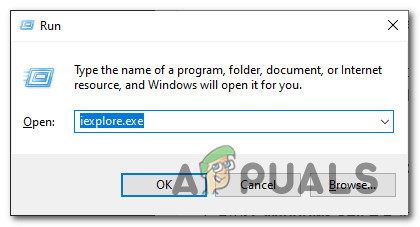
Opening Internet Explorer via Run command - Inside Internet Explorer, click on the gear icon (top right corner of the window), then click on Manage add-ons from the context menu that just appeared.
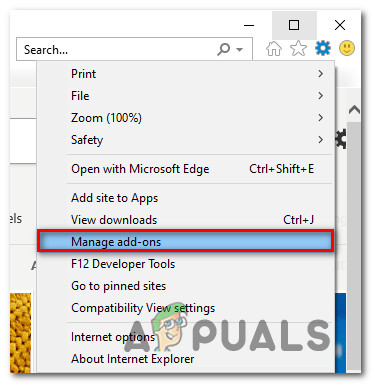
Accessing the Manage Add-ons menu - Once you’re inside the Manage Add-ons menu, click on Toolbars and Extensions (under Add-on Types).
- With the Toolbars and Extensions menu selected, click on an item from the right-hand side menu and press Ctrl + A to select everything inside.
After every item is successfully selected, right-click on any selected item and choose Disable all from the newly appeared context menu.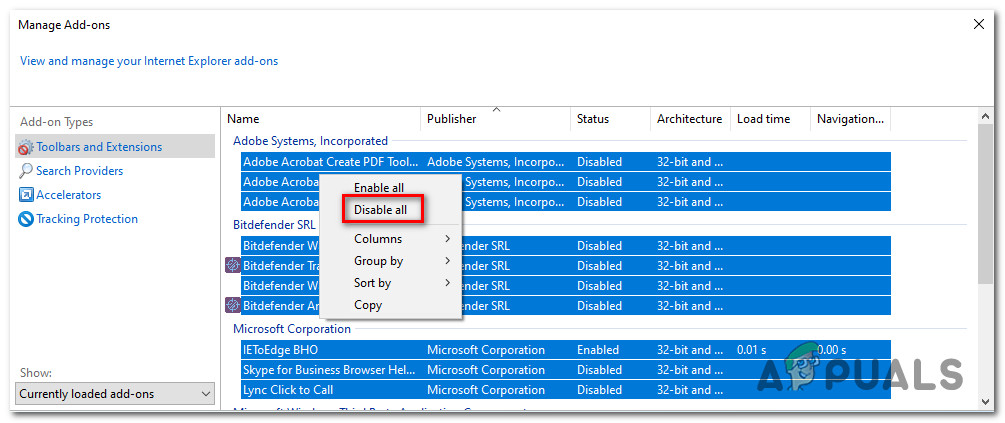
Disabling every Internet Explorer addon - Once you manage to effectively disable every enabled IE Extension, restart the browser and see if the error message is fixed.
In case you still end up seeing the ‘Res IEFrame DLL ACR_Error.HRM‘ error, move down to the next potential fix below.
Method 2: Resetting Internet Explorer
Assuming the issue is being caused by a setting enforced by Internet Explorer, you should be able to fix the problem by resetting the current lineup of settings that are governing your default browser.
A lot of affected users have confirmed that the problem was fixed (the issue was caused by a failing script) after they effectively reset Internet Explorer from the Internet Options menu.
If you think this scenario might be applicable, follow the instructions below to reset Internet Explorer and fix the ‘Res IEFrame DLL ACR_Error.HRM‘ error:
- Press Windows key + R to open up a Run dialog box. Next, type ‘inetcpl.cpl’ inside the text menu and press Enter to open up the Internet Properties menu.
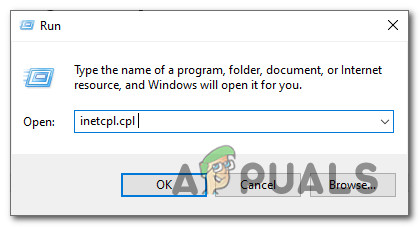
Opening the Internet Options menu Note: When you are prompted by the UAC (User Account Control), click Yes to grant admin access.
- Once you’re inside the Internet Properties screen, use the menu at the top to click on the Advanced tab.
- Next, click on the Reset button (under Reset Internet Explorer settings). When prompted by the Reset Internet Explorer settings menu, check the box associated with Delete personal settings before clicking on Reset.
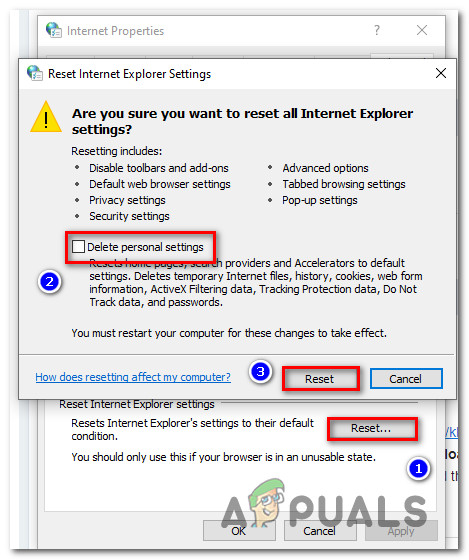
Resetting Personal Settings - Wait until the operation is complete, then click on the Close button once the operation is completed successfully.
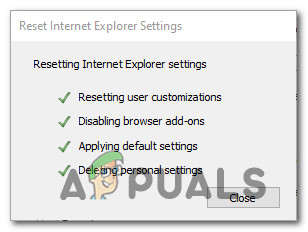
Completion Prompt - Restart your computer, launch Internet Explorer once again and see if the issue is now fixed.
If the same ‘Res IEFrame DLL ACR_Error.HRM‘ error is still occurring, move down to the next potential fix below.
Method 3: Clear any temporary IE Files
According to some affected users, this problem can also surface due to some type of corrupted information that is currently stored by Internet Explorer as a temporary file.
Several affected users have managed to fix this problem by accessing the Tools menu of IE and deleting every cookie and cached file that is currently being stored in between browser startups.
Here’s a quick step-by-step guide that will walk you through the process of cleaning all your temporary files from Internet Explorer:
- Press Windows key + R to open up a Run dialog box. Next, type ‘iexplore.exe’ inside the text box and press Enter to open up Internet Explorer.

Opening Internet Explorer via Run command - When you’re inside the home page of Internet Explorer, click on the gear icon from the top-right section of the screen, then click on Internet Options from the context menu that just appeared.
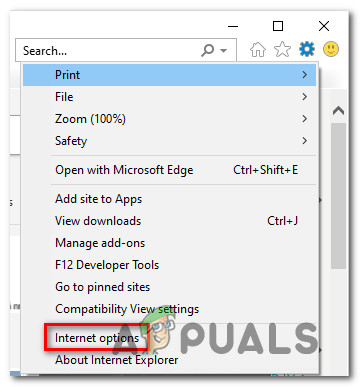
Opening the Internet Options menu - Once you’re inside the Internet Options menu, click on the General tab from the menu at the top, then click on the Delete button (under Browsing history).

Deleting the browsing history - From the Delete Browsing History menu, check the boxes associated with Temporary Internet files and website files and Cookies and website data while leaving everything else unchecked. When ready, click on Delete and confirm at the prompt to get rid of every temporary file that your IE browser is currently storing.
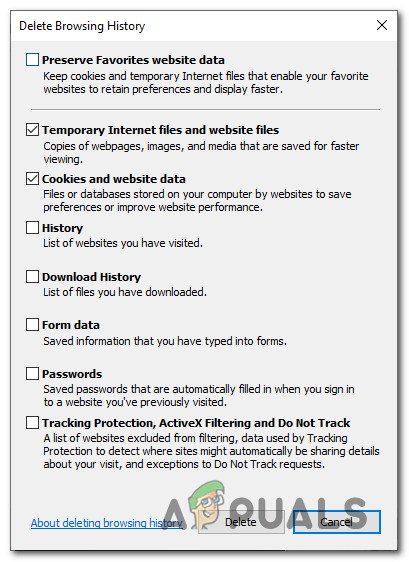
Deleting Browser History - Wait until the operation is complete, then restart your computer and see if the error message is fixed once the next startup is complete.
If the same ‘Res IEFrame DLL ACR_Error.HRM‘ error is still popping up when you attempt to open Internet Explorer, move down to the next potential fix below.
Method 4: Running a Custom CCleaner Scan
As it turns out, this issue can also occur due to some type of corrupted registry files that are affecting the functionality of Internet Explorer. Some affected users have confirmed that they managed to get the issue resolved entirely after they’ve fixed an instance in which the IE browser contained some corrupted files that the auto-cleanup function was unable to clear automatically.
In case this scenario is applicable in your particular scenario, you should be able to fix the problem by cleaning the corrupted IE files using a third-party tool capable of doing this. Most affected users that were previously dealing with the ‘Res IEFrame DLL ACR_Error.HRM‘ error has managed to fix the problem using the CCleaner utility.
Here’s a quick step-by-step guide that will allow you to clean your corrupted files hive via CCleaner:
- Open your default browser and access the official download page of CCleaner. The download should start automatically.
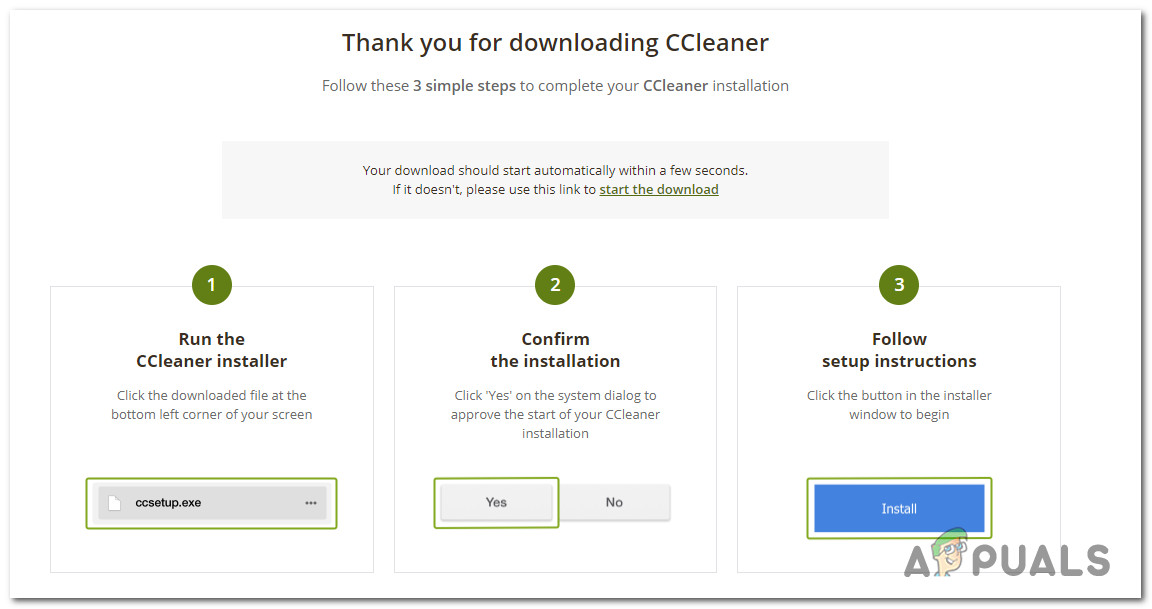
Downloading CCleaner Note: If the download doesn’t start automatically, manually click on the download hyperlink to force the download to start manually.
- Once the installer is downloaded completely, double-click on it and click Yes at the User Account Control prompt to grant admin access.
- Next, follow the on-screen instructions to complete the installation of CCleaner.
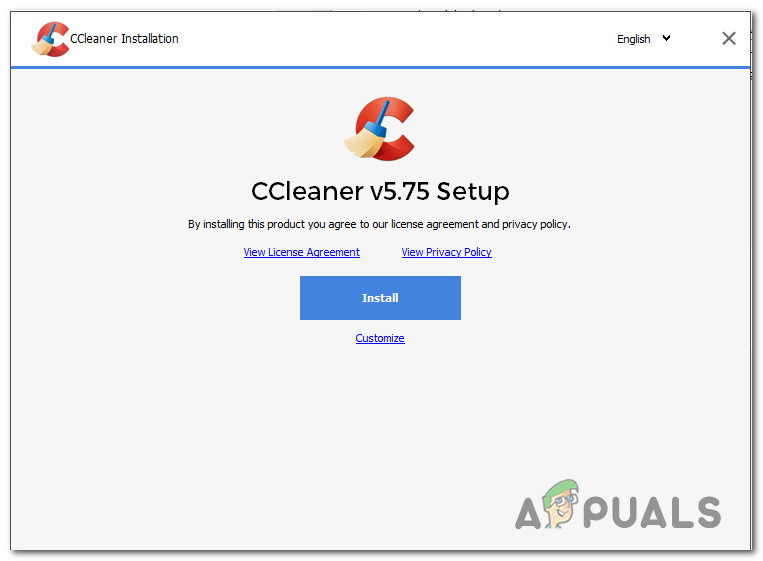
Installing CCleaner Note: If you’re prompted by an optional offer and asked to install a PUP, click on Decline.
- Wait until the installation is complete, then run CCleaner normally.
- Once you’re inside CCleaner, click on Custom Clean from the vertical menu on the left.
- Next, check every box associated with Microsoft Edge and Internet Explorer and unchecked everything else before clicking on Run Cleaner.
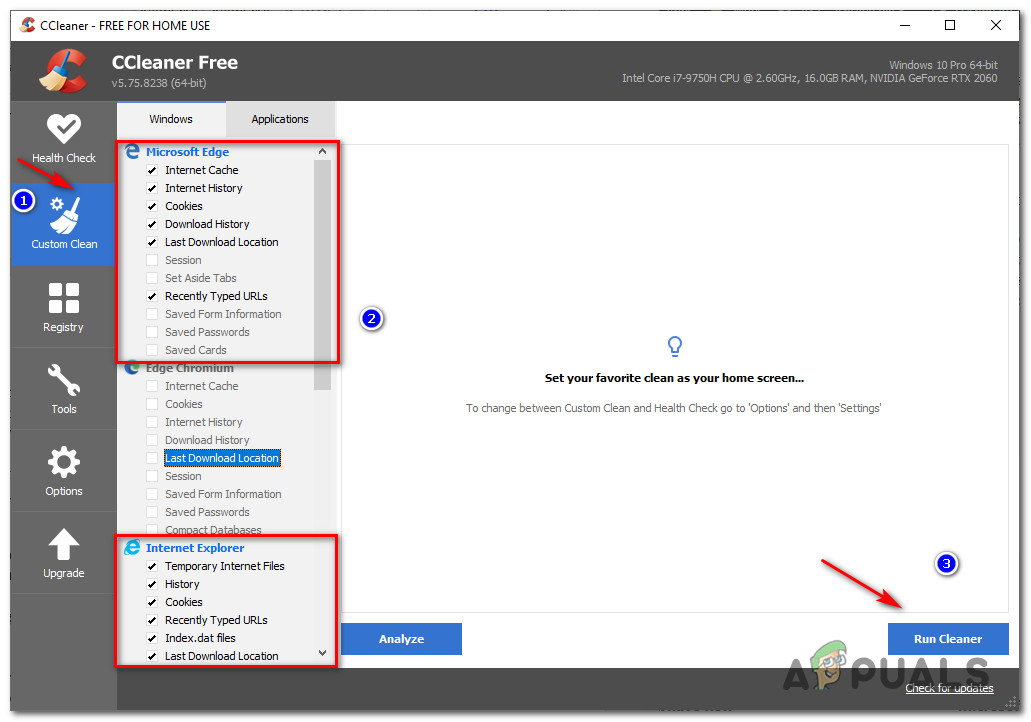
Cleaning items associated with Internet Explorer - Once the scan has been completed and CCleaner successfully eliminates any corrupted temp file, restart your computer manually and see if the issue is fixed once the next startup is complete.
Method 5: Installing the Java Runtime Environment
According to some affected users, you might also expect to encounter this issue in an instance where your Windows installation is missing the Java Runtime Environment. This can become an issue since a lot of add-ons that Internet Explorer might be using depend on it in order to run properly.
If you’re still encountering the ‘Res IEFrame DLL ACR_Error.HRM‘ error and you are missing the JRE, follow the instructions below to install it using the official channels.
Here’s a quick step by step guide that will walk you through the process of installing the Java Runtime Environment on your Windows computer:
- Open a browser that’s still working and visit the official download page of Java Runtime.
- Once you’re on the correct page, click on the Java Download, then click on the Agree and Start Free Download button.

Downloading the latest Java version - Once the download is finally complete, double-click on the JRE executable and follow the on-screen prompts to complete the installation of the Java Runtime Environment.
Note: When you’re prompted by the UAC (User Account Control), click Yes to grant admin access. - Once the installation of JRE is completed, restart your computer and see if the same ‘Res IEFrame DLL ACR_Error.HRM‘ error still appears when you try to open Internet Explorer.
If the same problem is still occurring in your particular scenario, move down to the final potential fix below.
Method 6: Running SFC and DISM Scans
If none of the methods above have worked for you, it’s possible that you’re dealing with some type of system file corruption that cannot be resolved conventionally. If this scenario is applicable, you should be able to fix the problem by running a couple of built-in utilities that are capable of fixing the most common causes of system file corruption.
You can use System File Checker (SFC) and DISM (Deployment Image Servicing and Management) to do scans capable of identifying and repairing corrupted system files. Keep in mind that even though the 2 utilities operate quite similarly, SFC and DISM have some key differences that make them ideal to be used in quick succession.
If you followed every potential fix above with no success, follow the instructions below to perform SFC and DISM scans in quick succession in order to fix the ‘Res IEFrame DLL ACR_Error.HRM‘ error:
- Open up a Run dialog box by pressing Windows key + R. Next, type ‘cmd’ inside the text box and press Ctrl + Shift + Enter to open up an elevated Command Prompt. When you’re prompted by the UAC (User Account Control), click Yes to grant admin access.

Open an elevated CMD prompt - Once you’re inside the elevated Command Prompt, type the following command and press Enter to initiate an SFC scan:
sfc /scannow
Note: This type of scan uses a locally stored archive to replace corrupted instances with healthy equivalents. Although no Internet connection is required, it’s important to ensure that the SFC scan is not interrupted once you start in order to avoid the creation of additional logical issues.
- Once the SFC scan is finally complete, restart your computer manually if you’re not automatically prompted to do so.
- After the next startup is complete, follow step 1 again to open up another elevated CMD prompt. This type, type the following command to initiate a DISM scan:
DISM /Online /Cleanup-Image /RestoreHealth
Note: Keep in mind that unlike SFC, DISM requires a permanent Internet connection because it uses a sub-component of Windows Update to download healthy files needed to replace the corrupted instances.
- Once the DISM scan is finally complete, restart your computer and launch Internet Explorer once the next startup is complete to see if the problem is now fixed.

